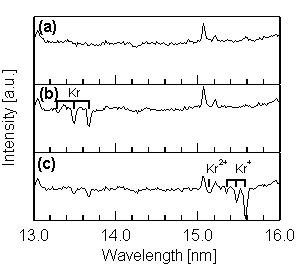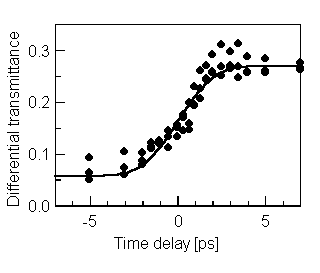Physical Science Laboratory
Ā@Recent developments in various ultrashort pulse x-ray sources based on a high-intensity femtosecond laser have made experimental demonstrations of time-resolved x-ray absorption and diffraction with picosecond to sub-picosecond resolution possible. The x-ray-pulse shape is one of the most important parameters because its duration limits the temporal resolution of this time-resolved x-ray spectroscopy. To date, an x-ray streak camera has usually been used for directly measuring x-ray pulses from nanosecond to picosecond, but its highest temporal resolution is currently about 0.9 ps. Therefore, to measure a sub-picosecond x-ray pulse, it is essential to extend the kind of correlation techniques usually used for measuring a femtosecond laser pulse to the x-ray region.
Ā@We demonstrated a cross-correlation technique for measuring an ultrashort soft x-ray-pulse shape using the rapid increase in Kr+ ion density caused by optical-field induced ionization, which operates as an ultrafast x-ray-absorption switch [1]. Using this technique, we measured a soft x-ray-pulse shape at 15.6 nm emitted from W plasma produced by a 100-fs laser pulse. Figure 1 shows typical time-integrated spectra. A broadband soft x-ray emission from W plasma is shown in Fig. 1 (a). In the transmission spectrum through Kr gas (Fig. 1 (b)), three absorption lines for neutral Kr atoms can be clearly observed near 13.5 nm. When Kr gas was irradiated by the ionizing pulse 3 ps before the arrival of the soft x-ray pulse, several Kr ion absorption lines appeared clearly while the absorption of neutral Kr decreased considerably (Fig. 1 (c)). We plotted the differential transmittance at 15.6 nm, which correspond to the absorption line of Kr+, as a function of the time delay between the laser and soft x-ray pulses (Fig. 2). The differential transmittance is the convolution of the soft x-ray pulse with the step-like change of the soft x-ray absorption. By fitting the integrated Gaussian function to the data, we found the full width at half maximum of the soft x-ray pulse to be 3.8 ps. This result agrees well with the duration measured with an x-ray streak camera thus confirming the feasibility of this technique. The most notable feature of this technique is that we can expect the temporal resolution to become shorter than the laser pulse duration, because the ionization is completed in the leading edge of the laser pulse.
[1] K. Oguri et al., Appl. Phys. Lett. 79 (2001) 4506.
 |
 |
||||
|
|